Understanding Key Signatures on Guitar: A Beginner’s Guide
Category: Music Theory
Unlock the Secrets of Key Signatures on Guitar
If you've just started learning guitar or are eager to deepen your music theory knowledge, understanding key signatures is essential. Many beginner guitarists struggle to make sense of key signatures — those little sharp (#) or flat (b) symbols at the beginning of a staff — and how they relate to the notes they play on the fretboard. You might have found yourself confused about why certain chords sound right together or why some notes fit better in a song’s scale. Maybe you’ve tried memorizing key signatures but can’t quite apply them when playing your favorite tunes. This blog post is designed specifically for you: a beginner musician who craves a clear, practical explanation of key signatures with direct application to guitar and piano. We’ll break down how key signatures work, how to identify them quickly, and how to translate that knowledge to your guitar playing, helping you unlock fretboard patterns and confidently jam in any key. Unlike dense, overly technical guides, this guide connects music theory directly to the fretboard with hands-on examples and easy-to-understand concepts. By the end, you’ll see how key signatures simplify your playing and open up creative possibilities, so keep reading to elevate your guitar skills and musical understanding.
- Unlock the Secrets of Key Signatures on Guitar
- What Are Key Signatures? An Introduction to Their Role in Music Theory
- The Circle of Fifths: A Visual Tool to Understand Key Signatures
- How Key Signatures Affect Notes and Scales on Guitar
- Identifying Major and Minor Key Signatures for Guitarists
- Reading Key Signatures on Sheet Music and Guitar Tabs
- Practical Tips for Playing Scales in Different Keys on Guitar
- Common Key Signatures Used in Popular Guitar Music
- Using Key Signatures to Build Chord Progressions on Guitar
- Connecting Key Signatures Between Guitar and Piano for Beginners
- Simple Exercises to Practice and Master Key Signatures on Guitar
What Are Key Signatures? An Introduction to Their Role in Music Theory
Understanding key signatures is a fundamental step in grasping how music is constructed and how different notes and chords relate to each other. Simply put, a key signature is a set of sharp (#) or flat (b) symbols placed at the beginning of a music staff that tells you which notes are consistently raised or lowered throughout a piece of music. This small but powerful notation helps define the key of a song, indicating the scale and tonal center around which the music revolves.
In practical terms, a key signature serves two main purposes:
- Establishing the Tonal Center (Key): It shows the “home” note or chord that the song is based on, such as C major, G major, or D minor. This tonal center determines the mood and feel of the music.
- Simplifying Notation: Instead of marking every single sharp or flat in the music, a key signature applies a rule to the entire piece so you know which notes to play or avoid without constant accidentals.
For guitarists and pianists, understanding key signatures unlocks the ability to recognize which scale patterns, chords, and progressions naturally fit together. It explains why some chord combinations sound harmonious and guides you in improvising or transposing songs into different keys. When you identify a key signature, you automatically know which notes are most common in that song, making it easier to navigate the fretboard or keyboard with confidence.
In upcoming sections, we’ll explore how to quickly identify key signatures and translate that knowledge into playable scales, chord shapes, and riffs, empowering you to play with precision and creativity in any key on your guitar or piano.
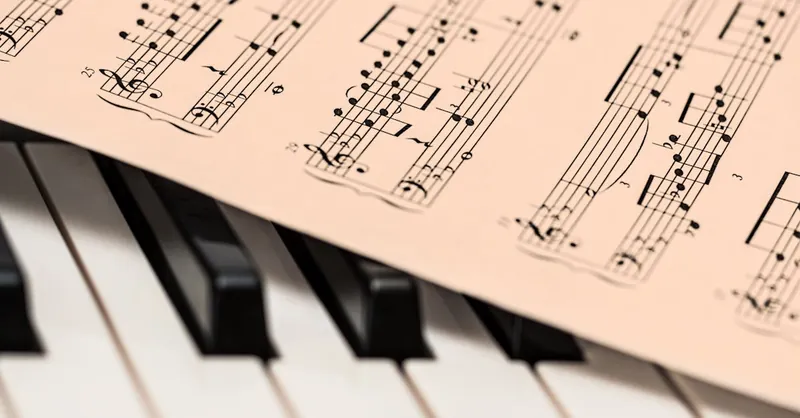
Image courtesy of Pixabay
The Circle of Fifths: A Visual Tool to Understand Key Signatures
One of the most powerful and beginner-friendly ways to grasp key signatures on guitar and piano is by using the Circle of Fifths. This circular diagram visually arranges all 12 keys in a sequence that moves by intervals of a perfect fifth — the same interval that defines many common chord progressions and scales. Starting from C major at the top (which has no sharps or flats), each step clockwise adds one sharp to the key signature, while moving counterclockwise adds one flat. This clear pattern makes the Circle of Fifths an invaluable reference for quickly identifying key signatures and their related scales.
Here’s why the Circle of Fifths is essential for musicians, especially guitarists and pianists:
- Effortless Memorization of Sharps and Flats: By following the circle, you can instantly recall how many sharps or flats a key has without memorizing long lists.
- Understanding Key Relationships: Keys that are next to each other on the circle are called closely related keys, sharing many common notes and chords. This knowledge helps you smoothly transition between keys when composing or improvising.
- Identifying Relative Minors: Every major key has a relative minor key that shares the same key signature. These are displayed inside or alongside the major keys in many Circle of Fifths charts, giving you quick insight into minor scale options for your playing.
- Practical Application on Guitar: When you know a key’s position on the circle, you can better visualize scale patterns and chord shapes that fit naturally together on the fretboard, making jamming and transposing simpler.
By integrating the Circle of Fifths into your practice routine, you turn abstract music theory into an intuitive, visual language that directly informs your playing. As you become comfortable with this tool, recognizing and using key signatures—whether sharp or flat—will feel less like memorization and more like a natural extension of your musical ear and muscle memory.

Image courtesy of Tima Miroshnichenko
How Key Signatures Affect Notes and Scales on Guitar
Understanding how key signatures influence the notes and scales you play is a vital building block for mastering the guitar fretboard. A key signature effectively defines which notes are consistently sharpened or flattened throughout a piece, shaping the specific scale patterns you’ll use when soloing, riffing, or composing. For example, the key of D major, with its two sharps (F# and C#), means you’ll naturally play the D major scale using those altered notes, rather than the natural F and C found in the C major scale. This tailored collection of notes helps create the distinct tonal flavor of each key and guides you in selecting the correct scale fingering patterns on the guitar neck.
How Scales Change Based on Key Signatures
When you know a song’s key signature, you can anticipate the exact scale notes to use without second-guessing. This eliminates confusion when switching keys or improvising over chord progressions. For instance, in the key of G major (one sharp: F#), your major scale pattern will always feature the F# note, regardless of where you play it on the fretboard. Conversely, if you move to the key of F major (one flat: Bb), you adjust your scale shapes to include B flats instead of B naturals—a crucial adaptation for accurate, musical playing.
Practical Guitar Applications of Key Signatures
- Scale Patterns: Each key signature corresponds to a set of notes you’ll find in the associated major or minor scale. Learning these scale shapes with their correct sharps or flats enables you to solo confidently and stay in key.
- Chord Construction: Key signatures determine which chords sound harmonious together. For example, the I-IV-V progression in C major (C, F, G) sticks to all natural notes, while in A major (three sharps: F#, C#, G#), the chords adjust accordingly. Recognizing this helps you choose the right chord voicings for rhythm playing or songwriting.
- Improvisation and Transposition: Once you internalize how key signatures affect your scale choices, you’ll find it easier to transpose songs to different keys, jam with musicians in varied tonalities, and create melodic solos that perfectly complement the harmony.
By mastering how key signatures dictate note selection on the guitar, you transform the fretboard from a collection of random frets into an organized map of musical possibility. This deep understanding will boost your ability to play fluidly across keys and unlock new creative potential, making your guitar practice more efficient, musical, and rewarding.
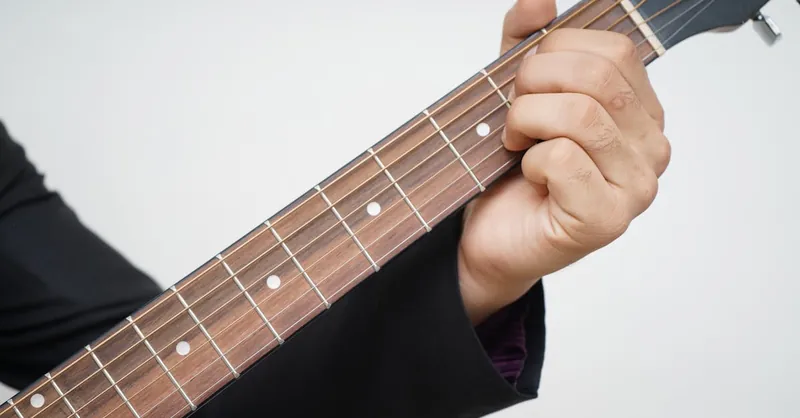
Image courtesy of Yogendra Singh
Identifying Major and Minor Key Signatures for Guitarists
For guitarists, distinguishing between major and minor key signatures is a crucial skill that deepens your understanding of song moods and scale choices. Each key signature not only defines the sharps or flats applied but also corresponds to both a major and a relative minor key sharing the same signature. Mastering this relationship helps you switch smoothly between major and minor tonalities, improving your improvisation, chord selection, and overall musicality.
How to Identify Major vs. Minor Key Signatures
- Look for the Key Signature Sharps or Flats: The number and type of accidentals (sharps or flats) at the beginning of a piece indicate the key signature.
- Determine the Major Key: Using the Circle of Fifths, identify the major key based on the sharps or flats present. For example:
- 2 sharps (F# and C#) correspond to D major.
- 3 flats (Bb, Eb, Ab) correspond to Eb major.
- Find the Relative Minor Key: Every major key has a relative minor that shares the same key signature. The relative minor is found by counting three semitones (or frets) down from the major key’s root note on the guitar. For example:
- D major’s relative minor is B minor (D → C# → B).
- Eb major’s relative minor is C minor.
Why This Matters for Guitar Players
- Scale Selection: Knowing the relative minor allows you to seamlessly switch between major and minor scales over the same chord progressions. This adds emotional variety to your solos and riffs.
- Chord Choices: Understanding whether a song is in a major or minor key helps you select the correct chord shapes and voicings. Minor keys tend to use minor, diminished, and sometimes altered chords that differ from the brighter major counterparts.
- Improvisation Flexibility: When jamming, quickly recognizing if the key signature points to a major or minor tonality guides your note choices instantly, letting you create melodic, fitting solos that highlight the song’s mood.
- Transposing Songs: Identifying both major and minor keys helps you move songs to different keys while maintaining their character, which is especially useful when arranging or accompanying singers.
By integrating this knowledge, you’ll not only decode key signatures faster but also make informed decisions about which scales and chords to play on your guitar. This skill bridges music theory with practical fretboard application, empowering you to play more expressively and confidently in any key, major or minor.
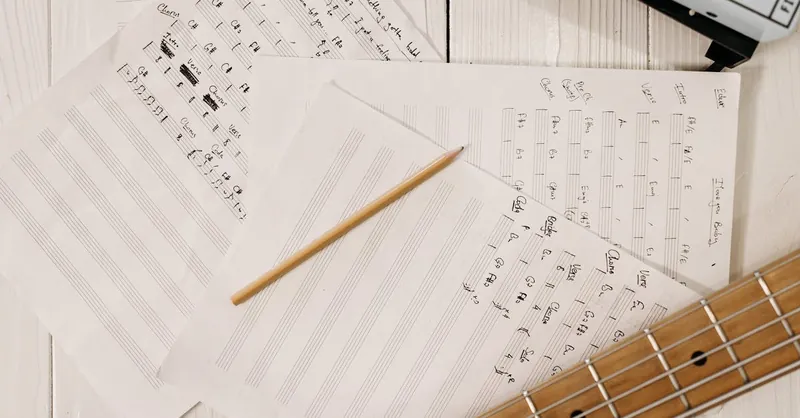
Image courtesy of Pavel Danilyuk
Reading Key Signatures on Sheet Music and Guitar Tabs
As a guitarist, being able to read key signatures on sheet music and guitar tabs is a foundational skill that bridges music theory with practical playing. When you open a piece of sheet music, the key signature appears right after the clef symbol—typically a treble clef for guitar—and before the time signature. This cluster of sharps (#) or flats (b) tells you which notes to consistently alter throughout the song, so you can anticipate the scale and chord structures without guesswork.
How to Interpret Key Signatures in Standard Notation
- Locate the Key Signature: Look immediately to the right of the clef at the start of the staff. The number and position of sharps or flats correspond to a specific key.
- Recall the Sharp or Flat Order: Sharps always follow the order F#, C#, G#, D#, A#, E#, B#, while flats follow Bb, Eb, Ab, Db, Gb, Cb, Fb. Knowing this sequence helps you quickly name the key—for example, two sharps usually mean D major or B minor.
- Adjust Notes Accordingly: Any note on the staff line or space that matches the sharp or flat in the key signature must be played altered throughout the piece unless an accidental indicates otherwise.
Reading Key Signatures in Guitar Tabs
Unlike standard notation, guitar tabs rarely display full key signatures because tabs focus on fret numbers rather than note names. However, many tab transcriptions include chord charts or specified keys above the tablature, which informs you about the key signature implicitly. Understanding key signatures helps you:
- Predict Sharps and Flats: Even without explicit accidentals in tabs, knowing the key signature tells you which notes are naturally sharp or flat, guiding your fingering and scale application.
- Identify Scale Patterns: If a tab shows a solo or melody in the key of G major (one sharp), you’ll expect to incorporate F# notes when playing scales or improvising.
- Transpose Tabs Easily: Knowing the key signature enables you to move entire tabs into different keys by adjusting fret positions while maintaining correct sharps and flats.
By confidently reading key signatures on sheet music and linking that knowledge to your guitar tabs, you gain a powerful advantage. You can quickly interpret unfamiliar pieces, align your fretboard choices with the song’s tonal center, and develop more intuitive musicality across all your guitar practice and performance settings.
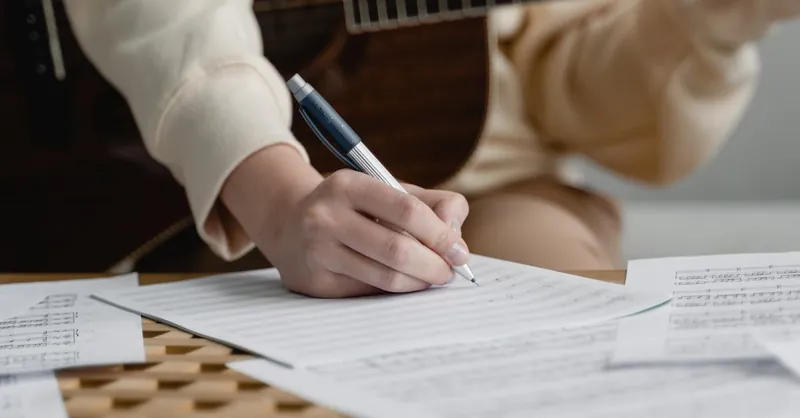
Image courtesy of Tima Miroshnichenko
Practical Tips for Playing Scales in Different Keys on Guitar
Mastering playing scales in various keys is a game-changer for expanding your guitar skills and musical versatility. Once you understand key signatures, the next step is to translate that theory into practical fretboard movement. Here are some clear, actionable tips to help you confidently play scales across all keys on your guitar:
-
Learn the Shape, Not Just the Notes: Most guitar scales are learned as patterns or shapes rather than isolated notes. Start by mastering a few common scale shapes (like the major scale’s five positions) and then practice shifting these patterns up or down the neck to play in different keys according to the key signature.
-
Use the Root Note as Your Anchor: Identify the root note of the scale on the low E (6th) string or A (5th) string. This root note determines the key you’re playing in. Moving the entire scale shape so the root aligns with different frets helps you instantly transpose the scale into new keys without relearning the pattern.
-
Apply the Correct Sharps or Flats Automatically: When you shift scale shapes, the key signature tells you which notes inside the pattern are altered (sharpened or flattened). For example, if you shift your C major scale shape (no sharps/flats) up two frets to D major, remember to include the F# and C# notes that belong to D major’s key signature. This mental map ensures your scales always match the key, keeping your solos and riffs sound accurate and musical.
-
Practice Alongside the Circle of Fifths: Connect your scale practice to the Circle of Fifths to reinforce the transition between keys. Moving clockwise on the circle adds sharps; moving counterclockwise adds flats. This helps you anticipate which notes to modify within your scale shapes as you explore new keys.
-
Incorporate Backing Tracks or Metronome Practice: To really internalize scales in different keys, play along with backing tracks or a metronome set to various key centers. This contextual practice reinforces the feel of each key signature on your fingers and trains your ear to recognize correct tonalities.
By integrating these tips into your practice routine, you'll develop a fluid ability to navigate scales in any key on the guitar. This skill enhances your improvisation, songwriting, and overall fretboard mastery, making every key switch feel natural and intuitive. Remember, consistent, focused practice of scale shapes informed by key signatures transforms abstract theory into real-world musicianship.

Image courtesy of Photo By: Kaboompics.com
Common Key Signatures Used in Popular Guitar Music
When diving into popular guitar music, certain key signatures appear more frequently due to their ease of playability on the guitar and the natural resonance of open strings in those keys. Familiarizing yourself with these common keys will not only speed up your learning but also help you quickly identify scales, chords, and progressions that dominate many hit songs.
Most Frequent Key Signatures in Popular Guitar Songs
-
E Major (4 sharps: F#, C#, G#, D#)
E major is a guitarist’s favorite because it aligns perfectly with the open strings of the guitar (E, B, G#, D, A, E). This key allows for comfortable open chord shapes like E, A, and B, which are staples in rock, pop, and blues. -
A Major (3 sharps: F#, C#, G#)
A major uses many open chords such as A, D, and E, making it highly approachable for beginners and widely used in genres like country, folk, and classic rock. Its relative minor, F# minor, also appears often for moodier songs. -
G Major (1 sharp: F#)
G major is iconic in guitar music due to its bright sound and open chord shapes (G, C, D). It frequently appears in acoustic singer-songwriter music and folk styles. -
C Major (no sharps or flats)
With no sharps or flats, C major is theoretically the simplest key signature. Although it lacks open bass strings, it’s still common in pop and classical guitar due to its straightforward scale structure and chord progression possibilities. -
D Major (2 sharps: F#, C#)
D major is popular in bluegrass and pop, with open chords like D, G, and A fitting naturally on the guitar. Its bright tonality suits upbeat songs and melodic solos.
Why These Keys Are Guitar-Friendly
- Open String Resonance: Guitarists leverage open strings to create fuller sounds and easier chord fingering, which is why keys like E, A, and G major dominate.
- Common Scale Patterns: The scale shapes and pentatonic patterns in these keys are some of the first patterns guitarists learn, leading to frequent use in riffing and soloing.
- Chord Progression Familiarity: The I-IV-V chord progressions in these keys are foundational to countless songs, making these keys practical for songwriting and jam sessions.
Understanding these common key signatures helps beginners quickly connect music theory with real-world guitar playing. By mastering scales and chords in these keys first, you’ll build a solid foundation that opens doors to more complex keys and genres, accelerating your growth as a versatile guitarist.
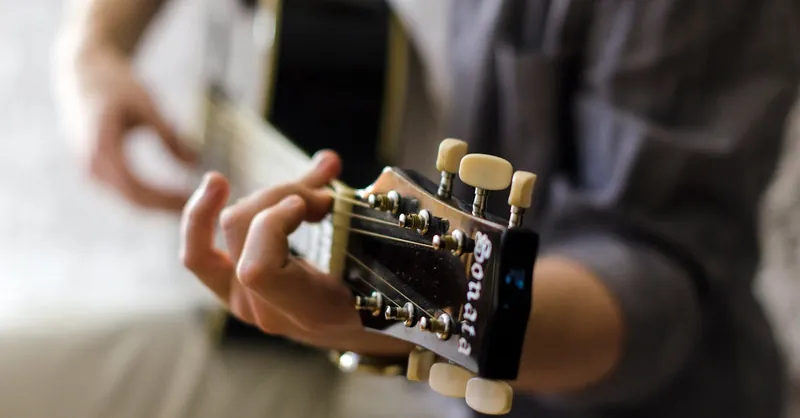
Image courtesy of Anastasia Lashkevich
Using Key Signatures to Build Chord Progressions on Guitar
Understanding key signatures is not just about recognizing scales or notes—it’s a powerful tool for constructing chord progressions that naturally fit together in any key. Once you know the key signature of a song, you can confidently select chords that belong to that key, ensuring your progressions sound cohesive and musical on the guitar.
How Key Signatures Guide Chord Choices
Each key signature defines a specific set of notes, and from those notes, you build the diatonic chords—chords formed by stacking thirds within the scale. For example, in the key of C major (no sharps or flats), the diatonic chords are:
| Scale Degree | Chord Type | Example in C Major |
|---|---|---|
| I | Major | C |
| ii | Minor | Dm |
| iii | Minor | Em |
| IV | Major | F |
| V | Major | G |
| vi | Minor | Am |
| vii° | Diminished | Bdim |
These seven chords form the palette from which you can craft countless progressions. The key signature ensures all chords use only the notes within that scale, keeping your harmony consistent and pleasing to the ear.
Applying This to Guitar Playing
- Identify the Key Signature: Knowing the key helps you instantly narrow down your chord options to the diatonic set. For instance, in G major (one sharp: F#), your primary chords will revolve around G, Am, Bm, C, D, Em, and F#dim.
- Learn Chord Shapes for Each Scale Degree: Practice the basic major, minor, and diminished chord shapes that correspond to each degree of the scale in various keys. This enables fluid transitions and more dynamic songwriting or accompaniment.
- Create Common Progressions: Start by mastering classic progressions like I-IV-V, ii-V-I, or vi-IV-I-V in different keys. These progressions form the backbone of many popular songs and are natural choices within any key signature.
- Experiment with Substitutions and Extensions: Once comfortable, use your knowledge of key signatures to add chord variations—such as seventh chords, suspended chords, or modal interchange—while still staying true to the tonal center defined by your key signature.
By leveraging key signatures to build your chord progressions, you cultivate a strong harmonic foundation that enhances your ability to compose, improvise, and accompany on guitar. This approach simplifies complex music theory into practical steps, empowering you to create musically rich progressions that fit any genre or style.

Image courtesy of SHVETS production
Connecting Key Signatures Between Guitar and Piano for Beginners
Understanding how key signatures function across both guitar and piano is a crucial step for beginner musicians looking to build a well-rounded foundation in music theory. While the guitar fretboard and piano keyboard are physically different, the concept of key signatures remains the same: they indicate which notes are consistently sharpened or flattened, defining the scale and tonal center of a piece. This shared framework allows guitarists and pianists to communicate musical ideas clearly and apply theory seamlessly when switching between instruments or collaborating.
How Key Signatures Translate Between Guitar and Piano
- Consistent Note Patterns: Whether you’re pressing a piano key or fretting a guitar string, a key signature affects the notes you use identically. For example, playing in the key of E major on piano means consistently including F#, C#, G#, and D#—the same applies when playing scales or chords on guitar.
- Visual Differences, Theoretical Similarities: Piano players see all notes laid out linearly, making key signatures visually apparent through white and black keys. Guitarists navigate a more spatial fretboard where the same note appears in multiple positions. Recognizing how key signatures dictate which notes to emphasize helps guitarists locate correct scale patterns, just as pianists identify correct keys.
- Shared Scale and Chord Shapes: When you learn a major or minor scale shape on the guitar for a certain key, you’re playing the same set of notes a pianist would use on the keyboard for that key signature. This commonality lets beginner musicians transpose understanding from one instrument to the other, accelerating skill development.
Why This Matters for Beginners
- Reinforces Music Theory Across Instruments: Understanding key signatures in both contexts turns music theory into a universal language, strengthening your overall musicianship.
- Simplifies Learning and Transposition: Knowing key signatures helps you transpose songs between guitar and piano effortlessly, making practice and collaboration smoother.
- Builds Confidence in Improvisation and Composition: With a solid grasp of key signatures, beginners can invent melodies or harmonies on either instrument with confidence, knowing which notes will harmonize correctly.
By connecting the dots between guitar and piano key signatures, beginners develop a powerful, transferable skill set that enhances playing, composing, and jamming across instruments. This holistic approach to key signatures opens doors to greater musical flexibility and creativity early in your learning journey.
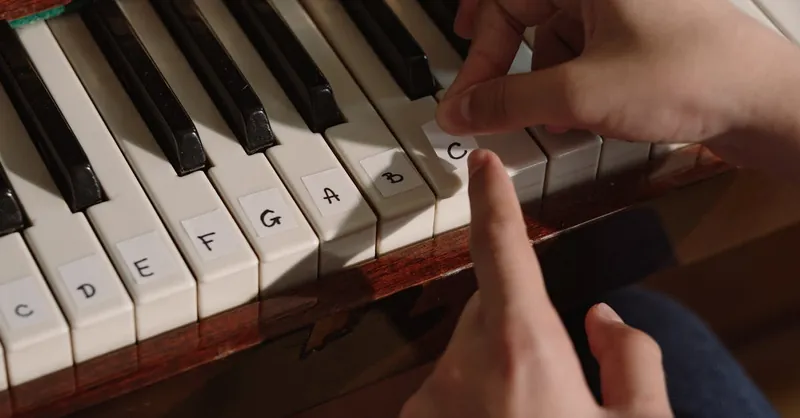
Image courtesy of cottonbro studio
Simple Exercises to Practice and Master Key Signatures on Guitar
Building a strong command of key signatures on guitar starts with consistent, focused practice using simple, effective exercises that embed the theory into your muscle memory and ear training. These exercises bridge the gap between understanding key signatures conceptually and applying them confidently on your fretboard, paving the way for fluent scale navigation, chord selection, and improvisation in any key.
1. Practice Major Scale Patterns in Different Keys
Start by selecting a major scale shape—for example, the open C major scale pattern—and shift it up the neck to play the same scale in various keys according to the key signatures. Focus on:
- Adjusting for sharps and flats based on the key signature (e.g., include F# and C# when playing D major).
- Identifying and emphasizing the root note of each key on the 6th or 5th string.
- Playing the scale ascending and descending smoothly while staying aware of the altered notes.
Repeating this exercise in keys with different numbers of sharps and flats reinforces your familiarity with key signatures and how they affect scale shapes on the guitar.
2. Build Chord Progressions Within a Key
Using the diatonic chords that belong to a specific key signature, create simple I-IV-V or ii-V-I progressions:
- Choose a key (e.g., G major with one sharp).
- Identify the chords that fit diatonically to the key signature (G, Am, Bm, C, D, Em, F#dim).
- Practice switching between these chords smoothly and in rhythm.
- Experiment by adding chords from the related relative minor key or modal interchange to hear the tonal center clearly.
This exercise trains your fingers and your ear to recognize how key signatures shape harmonic movement on guitar.
3. Ear Training Using Key Signatures
Play or listen to melodies or backing tracks in a particular key and:
- Identify the key signature by listening for sharps or flats.
- Solo or improvise using the corresponding major or minor scale.
- Focus on landing on the root note and resolving phrases within the key to reinforce tonal center awareness.
This listening-based exercise helps internalize how key signatures influence the sound of music and improves your improvisational intuition.
4. Transpose Simple Melodies or Riffs into Different Keys
Take a familiar melody or riff and:
- Write down its original key signature.
- Practice moving it up or down the neck by one or more semitones.
- Adjust sharps and flats according to the new key signature.
- Play the transposed melody smoothly, listening for notes that should be sharpened or flattened as per the new key.
Transposing challenges your understanding of key signatures in a practical context and boosts your fretboard versatility.
By integrating these simple yet powerful exercises into your guitar practice, you’ll strengthen your grasp of key signatures and develop the ability to fluently apply this crucial music theory knowledge across all keys. This results in improved scale mastery, chord fluency, and creative freedom—foundations for confident, dynamic guitar playing.
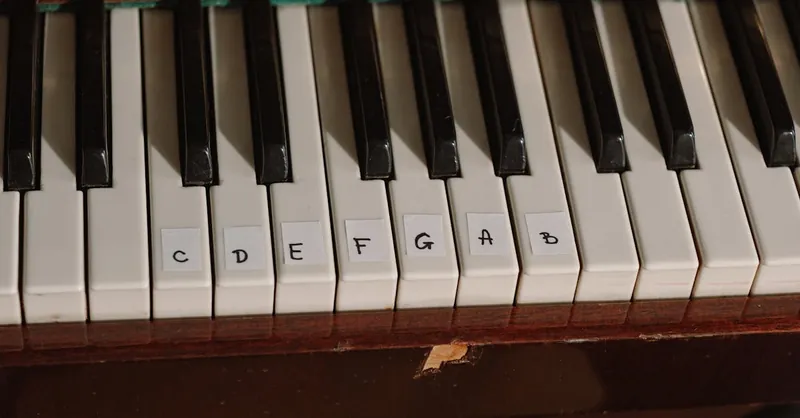
Image courtesy of cottonbro studio
